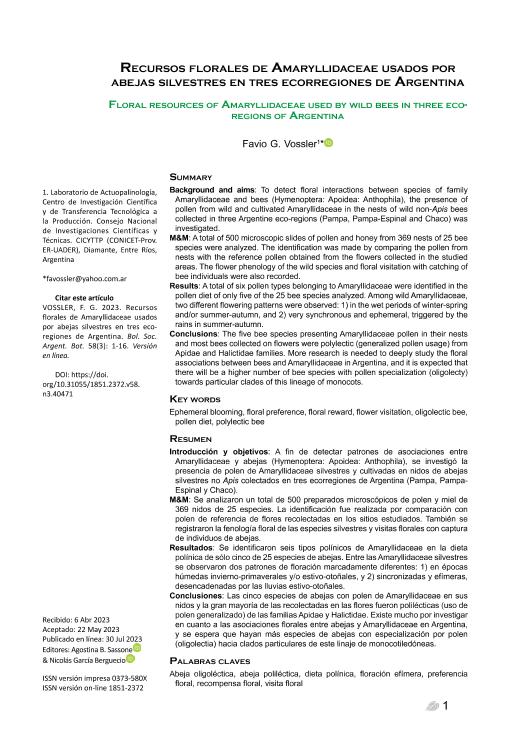Mostrar el registro sencillo del ítem
dc.contributor.author
Vossler, Favio Gerardo

dc.date.available
2024-04-05T11:49:32Z
dc.date.issued
2023-07
dc.identifier.citation
Vossler, Favio Gerardo; Recursos florales de Amaryllidaceae usados por abejas silvestres en tres ecorregiones de Argentina; Sociedad Argentina de Botánica; Boletín de la Sociedad Argentina de Botánica; 58; 3; 7-2023; 461-476
dc.identifier.issn
0373-580X
dc.identifier.uri
http://hdl.handle.net/11336/232045
dc.description.abstract
Introducción y objetivos: A fin de detectar patrones de asociaciones entre Amaryllidaceae y abejas (Hymenoptera: Apoidea: Anthophila), se investigó la presencia de polen de Amaryllidaceae silvestres y cultivadas en nidos de abejas silvestres no Apis colectados en tres ecorregiones de Argentina (Pampa, Pampa-Espinal y Chaco). M&M: Se analizaron un total de 500 preparados microscópicos de polen y miel de 369 nidos de 25 especies. La identificación fue realizada por comparación con polen de referencia de flores recolectadas en los sitios estudiados. También seregistraron la fenología floral de las especies silvestres y visitas florales con captura de individuos de abejas. Resultados: Se identificaron seis tipos polínicos de Amaryllidaceae en la dieta polínica de sólo cinco de 25 especies de abejas. Entre las Amaryllidaceae silvestres se observaron dos patrones de floración marcadamente diferentes: 1) en épocas húmedas invierno-primaverales y/o estivo-otoñales, y 2) sincronizadas y efímeras, desencadenadas por las lluvias estivo-otoñales. Conclusiones: Las cinco especies de abejas con polen de Amaryllidaceae en sus nidos y la gran mayoría de las recolectadas en las flores fueron polilécticas (uso de polen generalizado) de las familias Apidae y Halictidae. Existe mucho por investigar en cuanto a las asociaciones florales entre abejas y Amaryllidaceae en Argentina, y se espera que hayan más especies de abejas con especialización por polen (oligolectia) hacia clados particulares de este linaje de monocotiledóneas.
dc.description.abstract
Background and aims: To detect floral interactions between species of family Amaryllidaceae and bees (Hymenoptera: Apoidea: Anthophila), the presence of pollen from wild and cultivated Amaryllidaceae in the nests of wild non-Apis bees collected in three Argentine eco-regions (Pampa, Pampa-Espinal and Chaco) was investigated. M&M: A total of 500 microscopic slides of pollen and honey from 369 nests of 25 bee species were analyzed. The identification was made by comparing the pollen from nests with the reference pollen obtained from the flowers collected in the studied areas. The flower phenology of the wild species and floral visitation with catching of bee individuals were also recorded. Results: A total of six pollen types belonging to Amaryllidaceae were identified in the pollen diet of only five of the 25 bee species analyzed. Among wild Amaryllidaceae, two different flowering patterns were observed: 1) in the wet periods of winter-spring and/or summer-autumn, and 2) very synchronous and ephemeral, triggered by the rains in summer-autumn. Conclusions: The five bee species presenting Amaryllidaceae pollen in their nests and most bees collected on flowers were polylectic (generalized pollen usage) from Apidae and Halictidae families. More research is needed to deeply study the floral associations between bees and Amaryllidaceae in Argentina, and it is expected that there will be a higher number of bee species with pollen specialization (oligolecty) towards particular clades of this lineage of monocots.
dc.format
application/pdf
dc.language.iso
spa
dc.publisher
Sociedad Argentina de Botánica

dc.rights
info:eu-repo/semantics/openAccess
dc.rights.uri
https://creativecommons.org/licenses/by-nc-nd/2.5/ar/
dc.subject
ABEJA OLIGOLÉCTICA
dc.subject
ABEJA POLILÉCTICA
dc.subject
DIETA POLÍNICA
dc.subject
FLORACIÓN EFÍMERA
dc.subject
PREFERENCIA FLORAL
dc.subject
RECOMPENSA FLORAL
dc.subject
VISITA FLORAL
dc.subject.classification
Ciencias de las Plantas, Botánica

dc.subject.classification
Ciencias Biológicas

dc.subject.classification
CIENCIAS NATURALES Y EXACTAS

dc.subject.classification
Ecología

dc.subject.classification
Ciencias Biológicas

dc.subject.classification
CIENCIAS NATURALES Y EXACTAS

dc.subject.classification
Zoología, Ornitología, Entomología, Etología

dc.subject.classification
Ciencias Biológicas

dc.subject.classification
CIENCIAS NATURALES Y EXACTAS

dc.title
Recursos florales de Amaryllidaceae usados por abejas silvestres en tres ecorregiones de Argentina
dc.title
Floral resources of Amaryllidaceae used by wild bees in three ecoregions of Argentina
dc.type
info:eu-repo/semantics/article
dc.type
info:ar-repo/semantics/artículo
dc.type
info:eu-repo/semantics/publishedVersion
dc.date.updated
2024-04-05T11:05:29Z
dc.identifier.eissn
1851-2372
dc.journal.volume
58
dc.journal.number
3
dc.journal.pagination
461-476
dc.journal.pais
Argentina

dc.description.fil
Fil: Vossler, Favio Gerardo. Provincia de Entre Ríos. Centro de Investigaciones Científicas y Transferencia de Tecnología a la Producción. Universidad Autónoma de Entre Ríos. Centro de Investigaciones Científicas y Transferencia de Tecnología a la Producción. Consejo Nacional de Investigaciones Científicas y Técnicas. Centro Científico Tecnológico Conicet - Santa Fe. Centro de Investigaciones Científicas y Transferencia de Tecnología a la Producción; Argentina
dc.journal.title
Boletín de la Sociedad Argentina de Botánica

dc.relation.alternativeid
info:eu-repo/semantics/altIdentifier/url/https://revistas.unc.edu.ar/index.php/BSAB/issue/view/2693
dc.relation.alternativeid
info:eu-repo/semantics/altIdentifier/doi/http://dx.doi.org/10.31055/1851.2372.v58.n3.40471
Archivos asociados
